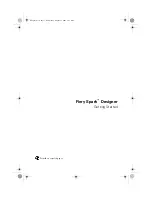
Chapter 22. Additional Information for IBM System z Users
236
Version : 00.90.00
Creation Time : Mon Mar 1 13:49:10 2004
Raid Level : raid0
Array Size : 15621632 (14.90 GiB 15.100 GB)
Raid Devices : 4
Total Devices : 4
Preferred Minor : 0
Persistence : Superblock is persistent
Update Time : Mon Mar 1 13:49:10 2004
State : dirty, noerrors
Active Devices : 4
Working Devices : 4
Failed Devices : 0
Spare Devices : 0
Chunk Size : 64K
Number Major Minor RaidDevice State
0 8 1 0 active sync /dev/sda1
1 8 17 1 active sync /dev/sdb1
2 8 33 2 active sync /dev/sdc1
3 8 49 3 active sync /dev/sdd1
UUID : 25c0f2a1:e882dfc0:c0fe135e:6940d932
Events : 0.1
22.3.2. Creating a Multipath Device With
mdadm
In addition to creating RAID arrays,
mdadm
can also be used to take advantage of hardware
supporting more than one I/O path to individual SCSI LUNs (disk drives). The goal of multipath storage
is continued data availability in the event of hardware failure or individual path saturation. Because this
configuration contains multiple paths (each acting as an independent virtual controller) accessing a
common SCSI LUN (disk drive), the Linux kernel detects each shared drive once "through" each path.
In other words, the SCSI LUN (disk drive) known as
/dev/sda
may also be accessible as
/dev/sdb
,
/dev/sdc
, and so on, depending on the specific configuration.
To provide a single device that can remain accessible if an I/O path fails or becomes saturated,
mdadm
includes an additional parameter to its
level
option. This parameter
multipath
directs the md layer
in the Linux kernel to re-route I/O requests from one pathway to another in the event of an I/O path
failure.
To create a multipath device, edit the
/etc/mdadm.conf
file to define values for the
DEVICE
and
ARRAY
lines that reflect your hardware configuration.
Note
Unlike the previous RAID example (where each device specified in
/etc/mdadm.conf
must represent different physical disk drives), each device in this file refers to the same
shared disk drive.
The command used for the creation of a multipath device is similar to that used to create a RAID
device; the difference is the replacement of a RAID level parameter with the
multipath
parameter:
mdadm C /dev/md0 level=multipath raiddevices=4 /dev/sda1 /dev/sdb1
/dev/sdc1 /dev/sdd1
Continue creating array? yes
Summary of Contents for ENTERPRISE LINUX 5 - VIRTUAL SERVER ADMINISTRATION
Page 12: ...xii ...
Page 20: ......
Page 30: ...12 ...
Page 32: ...14 ...
Page 82: ...64 ...
Page 106: ...88 ...
Page 122: ...104 ...
Page 124: ...106 ...
Page 126: ......
Page 132: ...114 ...
Page 168: ...150 ...
Page 182: ...164 ...
Page 192: ...174 ...
Page 194: ......
Page 236: ...218 ...
Page 238: ...220 ...
Page 270: ......
Page 274: ...256 ...
Page 278: ...260 ...
Page 292: ...274 ...
Page 294: ......
Page 300: ...282 ...
Page 304: ......
Page 316: ...298 ...
Page 370: ...352 ...
Page 384: ...366 ...
Page 385: ...Part VII Appendix ...
Page 386: ......
















































